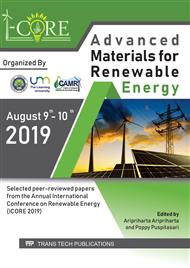[1]
J. C. Huang, J. P. Chu, and J. S. C. Jang, Recent progress in metallic glasses in Taiwan, Intermetallics, vol. 17, no. 12, (2009) p.973–987.
DOI: 10.1016/j.intermet.2009.05.004
Google Scholar
[2]
A. Inoue and A. Takeuchi, Recent development and application products of bulk glassy alloys, Acta Mater., vol. 59, no. 6, (2011) p.2243–2267.
DOI: 10.1016/j.actamat.2010.11.027
Google Scholar
[3]
T. Egami, Understanding the properties and structure of metallic glasses at the atomic level, JOM, vol. 62, no. 2, (2010) p.70–75.
DOI: 10.1007/s11837-010-0036-4
Google Scholar
[4]
A. Hirata et al., Direct observation of local atomic order in a metallic glass, Nat. Mater., vol. 10, p.28, Nov. (2010).
Google Scholar
[5]
A. Inoue and T. Zhang, Fabrication of Bulk Glassy Zr55Al10Ni5Cu30 Alloy of 30 mm in Diameter by a Suction Casting Method, Mater. Transitions, vol. 37, (1996) p.185–187.
DOI: 10.2320/matertrans1989.37.185
Google Scholar
[6]
X. Hui et al., High-zirconium-based bulk metallic glasses with large plasticity, Scr. Mater., vol. 63, no. 2, (2010) p.239–242.
Google Scholar
[7]
T. H. Li et al., Significantly enhanced mechanical properties of ZrAlCo bulk amorphous alloy by microalloying with Ta, Intermetallics, vol. 93, no. (2018) p.162–168.
DOI: 10.1016/j.intermet.2017.12.008
Google Scholar
[8]
N. K. Maroju, D. P. Yan, B. Xie, and X. Jin, Investigations on surface microstructure in high-speed milling of Zr-based bulk metallic glass, J. Manuf. Process., vol. 35, no. June, (2018) p.40–50.
DOI: 10.1016/j.jmapro.2018.07.020
Google Scholar
[9]
X. Chen, J. Xiao, Y. Zhu, R. Tian, X. Shu, and J. Xu, Micro-machinability of bulk metallic glass in ultra-precision cutting, Mater. Des., vol. 136, (2017) p.1–12.
DOI: 10.1016/j.matdes.2017.09.049
Google Scholar
[10]
M. Bakkal, Electron microscopy of bulk metallic glass machining chips, J. Non. Cryst. Solids, vol. 355, no. 45–47, (2009) p.2220–2223.
DOI: 10.1016/j.jnoncrysol.2009.07.018
Google Scholar
[11]
J. D. Patel and K. D. Maniya, A Review on : Wire cut electrical discharge machining process for metal matrix composite, Procedia Manuf., vol. 20, (2018) p.253–258.
DOI: 10.1016/j.promfg.2018.02.037
Google Scholar
[12]
C. Liu, N. Duong, M. P. Jahan, J. Ma, and R. Kirwin, Experimental investigation and numerical simulation of micro-EDM of bulk metallic glass with focus on crater sizes, Procedia Manuf., vol. 34, (2019) p.275–286.
DOI: 10.1016/j.promfg.2019.06.151
Google Scholar
[13]
H. G. Cheong, Y. S. Kim, and C. N. Chu, Effect of reverse current on tool wear in micro-electrical discharge milling, Precis. Eng., vol. 55 (2019) pp.484-490.
DOI: 10.1016/j.precisioneng.2018.11.003
Google Scholar
[14]
T. Muthuramalingam and B. Mohan, A review on influence of electrical process parameters in EDM process, Arch. Civ. Mech. Eng., vol. 15, 1 (2015) p.87–94.
DOI: 10.1016/j.acme.2014.02.009
Google Scholar
[15]
H. Huang and J. Yan, On the surface characteristics of a Zr-based bulk metallic glass processed by microelectrical discharge machining, Appl. Surf. Sci., vol. 355, (2015) p.1306–1315.
DOI: 10.1016/j.apsusc.2015.08.239
Google Scholar
[16]
S. H. Yeo, P. C. Tan, E. Aligiri, S. B. Tor, and N. H. Loh, Processing of Zirconium-Based Bulk Metallic Glass (BMG) Using Micro Electrical Discharge Machining (Micro-EDM), Mater. Manuf. Process., vol. 24, no. 12, (2009) p.1242–1248.
DOI: 10.1080/10426910903129661
Google Scholar
[17]
C. C. Wang and B. H. Yan, Blind-hole drilling of Al2O3 / 6061Al composite using rotary electro-discharge machining, J. Mater. Prosc. Technol. vol. 102, (2000) p.90–102.
DOI: 10.1016/s0924-0136(99)00423-9
Google Scholar
[18]
B. Mohan, A. Rajadurai, and K. G. Satyanarayana, Effect of SiC and rotation of electrode on electric discharge machining of Al - SiC composite, J. Mater. Prosc. Technol. vol. 124, (2002) pp.297-304.
DOI: 10.1016/s0924-0136(02)00202-9
Google Scholar
[19]
S. H. Yeo, P. C. Tan, E. Aligiri, S. B. Tor, and N. H. Loh, Processing of Zirconium-Based Bulk Metallic Glass (BMG) Using Micro Electrical Discharge Machining (Micro-EDM), Mater. Manuf. Process., vol. 24, no. 12, (2009) p.1242–1248.
DOI: 10.1080/10426910903129661
Google Scholar
[20]
A. Kumar and K. Æ. L. C. Pathak, Microanalysis of debris formed during electrical discharge machining ( EDM ), J. Mater. Sci., vol. 42, (2007) p.872–877.
DOI: 10.1007/s10853-006-0020-0
Google Scholar
[21]
U. Maradia, M. Boccadoro, J. Stirnimann, F. Kuster, and K. Wegener, Electrode wear protection mechanism in meso – micro-EDM, J. Mater. Process. Technol., vol. 223, (2015) p.22–33.
DOI: 10.1016/j.jmatprotec.2015.03.039
Google Scholar
[22]
J. Murray, D. Zdebski, and A. T. Clare, Workpiece debris deposition on tool electrodes and secondary discharge phenomena in micro-EDM, J. Mater. Process. Technol., vol. 212, no. 7, (2012) p.1537–1547.
DOI: 10.1016/j.jmatprotec.2012.02.019
Google Scholar
[23]
H. G. Cheong, Y. S. Kim, and C. N. Chu, Effect of reverse current on tool wear in micro-electrical discharge milling, Precis. Eng., vol. 55, (2019) p.484–490.
DOI: 10.1016/j.precisioneng.2018.11.003
Google Scholar
[24]
P. Taylor, T. Muthuramalingam, and B. Mohan, Influence of Discharge Current Pulse on Machinability in Electrical Discharge Machining, Materials and Manufacturing Processes no. October, (2013) p.37–41.
DOI: 10.1080/10426914.2012.746700
Google Scholar
[25]
H. Huang and J. Yan, Microstructural changes of Zr-based metallic glass during micro-electrical discharge machining and grinding by a sintered diamond tool, J. Alloys Compd., vol. 688, (2016) p.14–21.
DOI: 10.1016/j.jallcom.2016.07.181
Google Scholar


